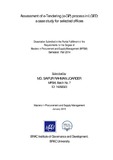| dc.description.abstract | The dissertation report titled as “Assessment of e-Tendering (e-GP) process in LGED: a case study for
selected offices” is submitted to the BRAC Institute of Governance and Development (BIGD), BRAC
University. Identification, analyzing, quantification and observing the efficiency gain of LGED through e-
Tendering process are the main purpose of this dissertation works. This report contains 5 (five) chapters.
Electronic Government Procurement (e-GP) solutions make purchasing activities more effective in
terms of both times, cost and as well as improve quality of the procurement methods by ensuring
compliance. e-GP is changing the way businesses purchase goods, works and services. Since most
products and services are procured using the Internet, the application of e-GP is inevitable in both
manufacturing and services. There are limited comparison studies in the literature on the adoption of e-
Procurement in a country, that is, at the specific organization-level. Nevertheless, such a study will
encourage other organizations to develop policies, strategies, and procedures to implement e-GP.
Understanding the importance of such a study, I have collected the data regarding compliance and time
issues are from secondary sources (websites) and conducted a questionnaire-based survey for cost
comparison after adoption of e-GP in LGED. The main objective of this study is to identify whether there
is any significant positive effect regarding the implementation of e-Procurement. A conceptual
framework has been developed for the adoption of e-GP, and this subsequently has been tested with
related data of LGED collected from websites and questionnaire-based survey. Also, this study
examines the current status of e-GP adoption in LGED. The results indicate both current and future
benefits would encourage the adoption of e-GP and make it sustain. Some critical success factors
include adequate financial support, availability of internet based communication systems, top
management support and commitment, enhancement of the manpower’s skill through rigorous training
activities, understanding the priorities of the organization and having suitable secured networks.
The Chapter 1 is termed as Introduction. e-GP system is launched in Bangladesh in the year 2011.
LGED with other three Government Agency RHD, REB and BWDB were committed to the Government
of Bangladesh that they will implement e-GP in their organization gradually. The target is fixed as 35%,
60%, 80% and 100% of the tender will be invited through e-GP in the year F.Y: 2013-14, F.Y: 2014-15,
F.Y: 2015-16 and F.Y:2016-17 respectively.
The title of Chapter 2 is Literature Review. This chapter explains only two issues one is the introduction
of e-Tendering process and its requirement, challenges & benefits. The other is its implication on different countries both developed and developing. In the context of developing country, discussion on
the procurement system of Bangladesh is also addressed.
The Chapter 3 describes acknowledgment of LGED. LGED’s function, objectives, organogram,
functional unit of LGED, areas of intervention and development out lay are briefed in this section.
Beside this the background of e-GP implementation in LGED, impact of PPRP-II (AF)’s DLI target on 4
target agency, LGED’s initiative to cope up the system it’s all tier gradually, present e-GP status on
LGED & expected future outcome is assessed. At last, a SWOT analysis is done to know the internal
strength and weakness of the organization in e-GP implementation. Furthermore, this analysis will show
the opportunity and threat of the organization that is external.
The Chapter 4 is the positive findings of e-GP implementation comparing with manual tendering
process based on collected data analysis and discussion. In order to identify and quantify the
assumption, logical and statistical analysis is done. In this chapter, for each assumption, research
methodology is also explained separately. It is schematically shown that e-Tender brought very
significant and high procurement performance outcome compare to manual tender on cost, quality and
time related areas of procurement process. In this regard it is not possible to collect a lot of
procurement related data from the offices where both types of tendering process are running
simultaneously. I have chosen my organization LGED and its’ 6 district PE offices as a sample for my
study. I have done a comparative analysis for different indicators under two tendering process within
same financial year (F.Y: 2012-13 & 2013-14). I have discussed case by case about the findings,
analysis and my views about the result. Finally I have introduced an overview about the findings.
The last Chapter of this dissertation contains conclusion, recommendation and future works.
Conclusion tells either e-GP provides the important principles of procurement such as economy and
efficiency and others compared to manual tender. As a researcher, it can be concluded that research
outcome will help the LGED as well as CPTU to take the strategic decision on e-GP and procurement
process as well as identify the present short comings. | en_US |

